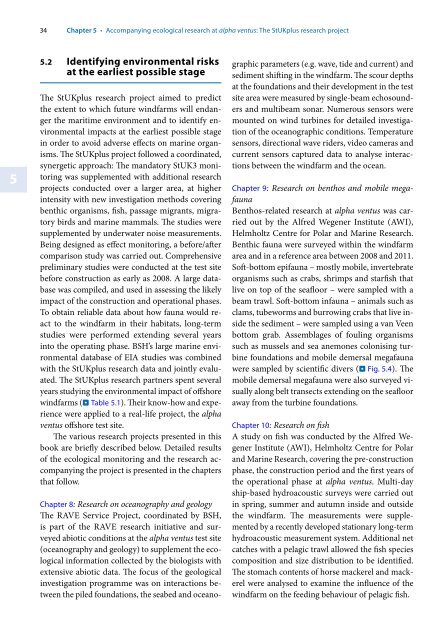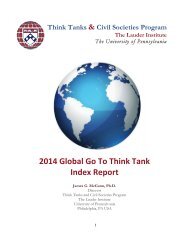bok%3A978-3-658-02462-8.pdf?auth66=1398409209_a0514c2b8e531c058ab8b810a0cad74d&ext=
bok%3A978-3-658-02462-8.pdf?auth66=1398409209_a0514c2b8e531c058ab8b810a0cad74d&ext=
bok%3A978-3-658-02462-8.pdf?auth66=1398409209_a0514c2b8e531c058ab8b810a0cad74d&ext=
- No tags were found...
You also want an ePaper? Increase the reach of your titles
YUMPU automatically turns print PDFs into web optimized ePapers that Google loves.
34Chapter 5 • Accompanying ecological research at alpha ventus: The StUKplus research project12345678910111213141516171819205.2 Identifying environmental risksat the earliest possible stageThe StUKplus research project aimed to predictthe extent to which future windfarms will endangerthe maritime environment and to identify environmentalimpacts at the earliest possible stagein order to avoid adverse effects on marine organisms.The StUKplus project followed a coordinated,synergetic approach: The mandatory StUK3 monitoringwas supplemented with additional researchprojects conducted over a larger area, at higherintensity with new investigation methods coveringbenthic organisms, fish, passage migrants, migratorybirds and marine mammals. The studies weresupplemented by underwater noise measurements.Being designed as effect monitoring, a before/aftercomparison study was carried out. Comprehensivepreliminary studies were conducted at the test sitebefore construction as early as 2008. A large databasewas compiled, and used in assessing the likelyimpact of the construction and operational phases.To obtain reliable data about how fauna would reactto the windfarm in their habitats, long-termstudies were performed extending several yearsinto the operating phase. BSH’s large marine environmentaldatabase of EIA studies was combinedwith the StUKplus research data and jointly evaluated.The StUKplus research partners spent severalyears studying the environmental impact of offshorewindfarms (. Table 5.1). Their know-how and experiencewere applied to a real-life project, the alphaventus offshore test site.The various research projects presented in thisbook are briefly described below. Detailed resultsof the ecological monitoring and the research accompanyingthe project is presented in the chaptersthat follow.Chapter 8: Research on oceanography and geologyThe RAVE Service Project, coordinated by BSH,is part of the RAVE research initiative and surveyedabiotic conditions at the alpha ventus test site(oceanography and geology) to supplement the ecologicalinformation collected by the biologists withextensive abiotic data. The focus of the geologicalinvestigation programme was on interactions betweenthe piled foundations, the seabed and oceanographicparameters (e.g. wave, tide and current) andsediment shifting in the windfarm. The scour depthsat the foundations and their development in the testsite area were measured by single-beam echosoundersand multibeam sonar. Numerous sensors weremounted on wind turbines for detailed investigationof the oceanographic conditions. Temperaturesensors, directional wave riders, video cameras andcurrent sensors captured data to analyse interactionsbetween the windfarm and the ocean.Chapter 9: Research on benthos and mobile megafaunaBenthos-related research at alpha ventus was carriedout by the Alfred Wegener Institute (AWI),Helmholtz Centre for Polar and Marine Research.Benthic fauna were surveyed within the windfarmarea and in a reference area between 2008 and 2011.Soft-bottom epifauna – mostly mobile, invertebrateorganisms such as crabs, shrimps and starfish thatlive on top of the seafloor – were sampled with abeam trawl. Soft-bottom infauna – animals such asclams, tubeworms and burrowing crabs that live insidethe sediment – were sampled using a van Veenbottom grab. Assemblages of fouling organismssuch as mussels and sea anemones colonising turbinefoundations and mobile demersal megafaunawere sampled by scientific divers (. Fig. 5.4). Themobile demersal megafauna were also surveyed visuallyalong belt transects extending on the seaflooraway from the turbine foundations.Chapter 10: Research on fishA study on fish was conducted by the Alfred WegenerInstitute (AWI), Helmholtz Centre for Polarand Marine Research, covering the pre-constructionphase, the construction period and the first years ofthe operational phase at alpha ventus. Multi-dayship-based hydroacoustic surveys were carried outin spring, summer and autumn inside and outsidethe windfarm. The measurements were supplementedby a recently developed stationary long-termhydroacoustic measurement system. Additional netcatches with a pelagic trawl allowed the fish speciescomposition and size distribution to be identified.The stomach contents of horse mackerel and mackerelwere analysed to examine the influence of thewindfarm on the feeding behaviour of pelagic fish.




